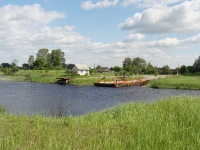- Home
- →
- Attractions
- →
- Dnieper-Bug Canal
Dnieper-Bug Canal
Dnieper–Bug Canal is an outstanding engineering monument and one of the oldest navigable canals in Eastern Europe. It is located in the Polesia region and connects the Pina and Mukhavets rivers, linking two major river basins — the Dnieper (Black Sea) and the Vistula (Baltic Sea). The total length of the canal is 244 km. The canal not only played an important role in the economy and defense of various states, but today it is also of interest as a unique landmark that can be explored during fascinating excursions across Belarus. Thanks to its natural surroundings, preserved locks, and historic hydraulic architecture, the Dnieper–Bug Canal attracts tourists who wish to discover the history and beauty of Polesia.
History of Construction
The idea of building a canal connecting the basins of the Pripyat and Western Bug rivers was first proposed in 1655 by the Crown Chancellor of the Polish–Lithuanian Commonwealth, Jerzy Ossoliński. However, its implementation only began in 1775 under King Stanisław August Poniatowski. Construction lasted eight years, and in the spring of 1784, cargo ships (carrying smoked fish, honey, wax) first sailed from Pinsk to Warsaw and Gdańsk via the canal. The canal was ceremonially opened by the king himself, who traveled along the new waterway — after that, the canal was named the Royal Canal.
Following the decline of the Commonwealth, construction and use of the canal were halted, but in 1837 the Russian authorities resumed work. Between 1846 and 1848, the canal was expanded, its depth increased, allowing regular navigation. At the end of the 19th century, the canal had strategic significance: torpedo boats were delivered via the canal to the Black Sea Fleet. Later, during the interwar period, Poland reconstructed part of the locks. After Western Belarus became part of the USSR, large-scale restoration and modernization efforts began. In 1940, the canal became navigable again, but during World War II it sustained serious damage. Due to partisan efforts, key hydraulic structures were destroyed. In 1945, the canal was restored, and navigation resumed.
Economic Significance
Since its creation, the Dnieper–Bug Canal played a key role in the development of trade and transportation. It enabled water transport of goods between Central Europe and the south of the Russian Empire. In the 19th century, both commercial and military vessels — including torpedo boats built in the Baltic and sent to Sevastopol — used the canal. During the Soviet era, the canal was also actively used for cargo transportation, especially after its restoration in the 1940s.
Today, the canal is part of the international waterway E-40 (Gdańsk — Warsaw — Brest — Pinsk — Mozyr — Kyiv — Kherson), theoretically connecting the Black and Baltic seas. However, due to the lack of navigation on some sections (e.g., from Brest to Warsaw), it has lost its economic value but gained new importance as a tourist site. Excursions across Belarus that include visits to the canal help promote historical heritage and regional tourism development.
Excursions with Canal Tours
The Dnieper–Bug Canal is an excellent destination for educational trips and nature tourism. Excursions across Belarus with visits to the canal include exploring the architecture of old locks, learning about the construction of the canal and its historical role, as well as walking along its scenic banks. Tourists can see preserved hydraulic structures, the unique landscapes of Polesia, and gain insight into the scale of engineering achievements of the 18th–20th centuries.
For tourist convenience, you can book an excursion with a canal tour, including a tour from Minsk. Such trips are usually designed for one day and include transfer, guide services, and a sightseeing program. The most popular routes pass through the cities of Brest, Pinsk, and Kobryn, where visitors can not only see the canal but also explore the cultural heritage of the region. You can book an excursion online at Ekskursii.by.

